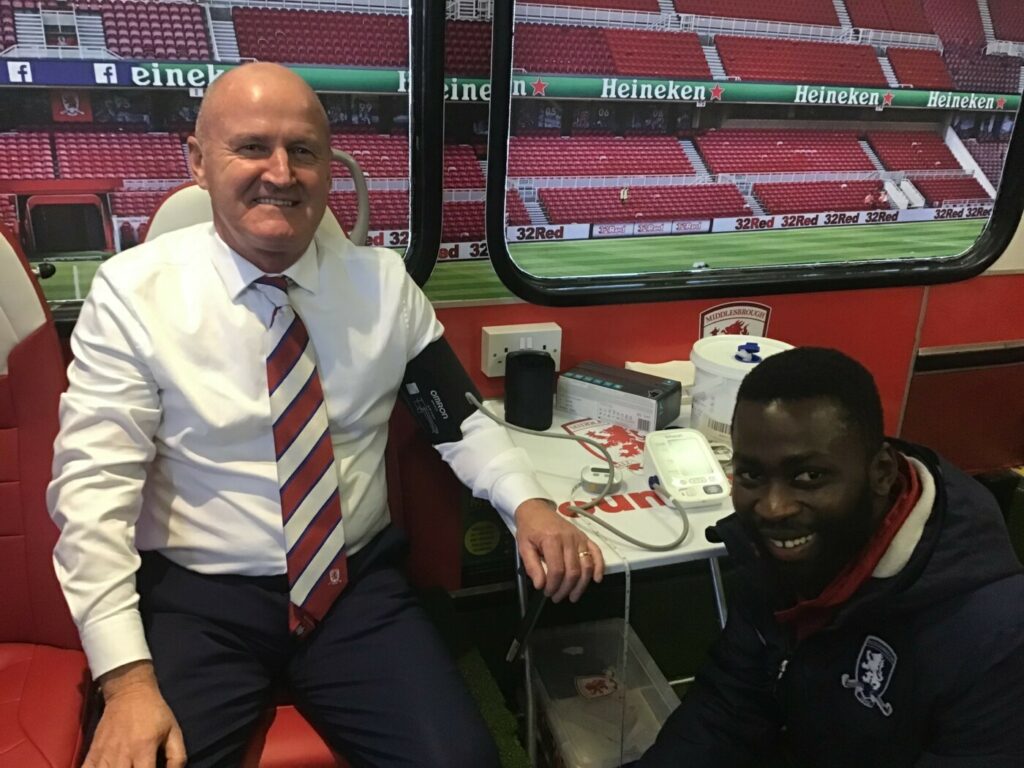Heart health checks offered in the community to reduce risk of ‘silent killer’
People from across Middlesbrough have benefited from heart health checks on offer at recent events in the town.
Two drop-in clinics were held where people could undertake a series of short tests to assess their risk of developing cardiovascular disease (CVD).
The health checks were delivered in partnership with Middlesbrough Football Club Foundation alongside Health Innovation North East and North Cumbria (HI NENC), working with communities in Middlesbrough that are at highest risk of dying due to CVD.
Middlesbrough has the highest mortality rate for CVD in the North East – with the disease causing more than 1 in 5[i] deaths in the area.
GPs offer a mandated NHS Health Check for people between 40 and 74 years of age but nationally available data suggests that people within Middlesbrough have a lower uptake of this service. This is due to a multitude of factors explored through recently conducted insights research as part of HI NENC’s Innovation in Healthcare Inequalities Programme (InHIP).
Reaching people within these communities is a key priority for HI NENC and its partners as part of a programme of work to raise awareness of CVD as a ‘silent killer’ condition and to therefore increase uptake of annual heart health checks.
The first pilot of the community healthy heart checks were held last month as part of National Cholesterol Month at Middlesbrough Football Club (MFC) before and after their match against Stoke City FC. The healthy heart checks were delivered in the MFC Foundation Health Bus onsite.
On the same day, the HI NENC team also held a further drop-in session at Victory Christian Ministries Church in Middlesbrough. A total of 54 people were tested on the day, with nine of those referred to speak to their GP based on their healthy heart check results.
The Healthy Heart Checks look at how healthy a person’s heart and blood circulatory system is, which can take between 10 to 20 minutes. It assesses the risk of having a heart attack, stroke, diabetes or other heart health problems.
The check involves collecting some health information to identify how at risk the person is to future heart health issues. This includes checking blood pressure, cholesterol levels, family history of heart health, body mass index (weight ratio between your height and weight) and then gives a score of the person’s risk of having heart diseases.
The checks involved using the PocDoc Lipid Test to take and record cholesterol readings. The test, which involves a finger prick blood test, a lateral flow device and an app, gives immediate results indicating whether the person has high cholesterol, whilst determining their CVD risk score as well which predicts the likelihood of future CVD events. It speeds up the diagnosis process meaning patients can receive treatment faster.
If abnormal readings were found, the HI NENC team discussed the results with the person, offered lifestyle advice and recommended that they speak to their GP.
Professor Julia Newton, Medical Director at HI NENC, said: “We have been working closely with communities across the region to understand how we can support people to take advantage of the annual heart health checks on offer to them. One of the ways we can help to break down barriers is to do more community outreach and by taking the health checks into the heart of communities, we have been able to reach people who might not have previously engaged with the check up via their GP.
“CVD is a silent killer and our work with partners to raise awareness and increase uptake of these potentially life-saving health checks could lead to earlier diagnosis of heart-related conditions, enabling those at risk to be treated and supported to live longer, healthier lives.
“This pilot community outreach acted as a testbed for future sessions in bespoke community settings, which we hope to include community hubs, mosques, and academic, sports and leisure settings.”
HI NENC’s work in this area forms part of its InHIP programme aimed at reducing avoidable premature CVD deaths and narrowing health inequalities within communities in the region that can typically be harder to reach.
Middlesbrough is one of the 20% most deprived authorities in England[ii], with high levels of health inequalities.
Paul South, Health and Wellbeing Manager at Middlesbrough FC Foundation, said: “The community health check event was positively received from club staff and the wider community alike. From a club perspective, staff found it beneficial having the opportunity to have health checks during work, as time was stated as a big barrier.
“In the community, many said unless it was provided close to where they lived, they wouldn’t think of going out of their way to go to their GP for a check-up. Also, one family said having the check was much easier when she saw one of the MFC staff who they knew; this took away any anxiety.”
[i] https://www.bhf.org.uk/-/media/files/health-intelligence/9/middlesbrough-ua-bhf-statistics.pdf
[ii] https://fingertips.phe.org.uk/static-reports/health-profiles/2019/e06000002.html?area-name=middlesbrough

